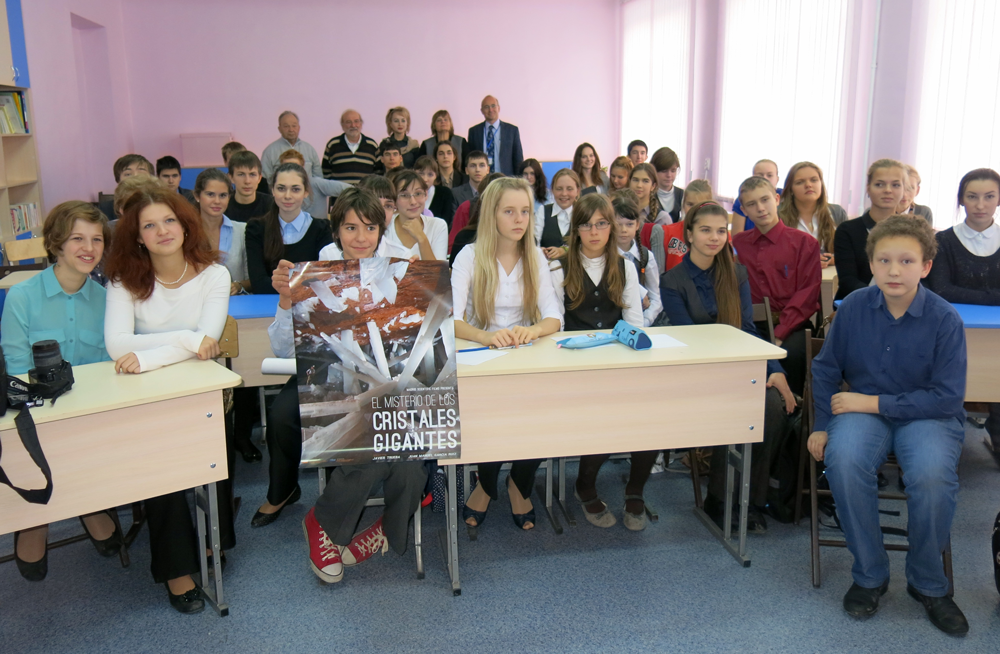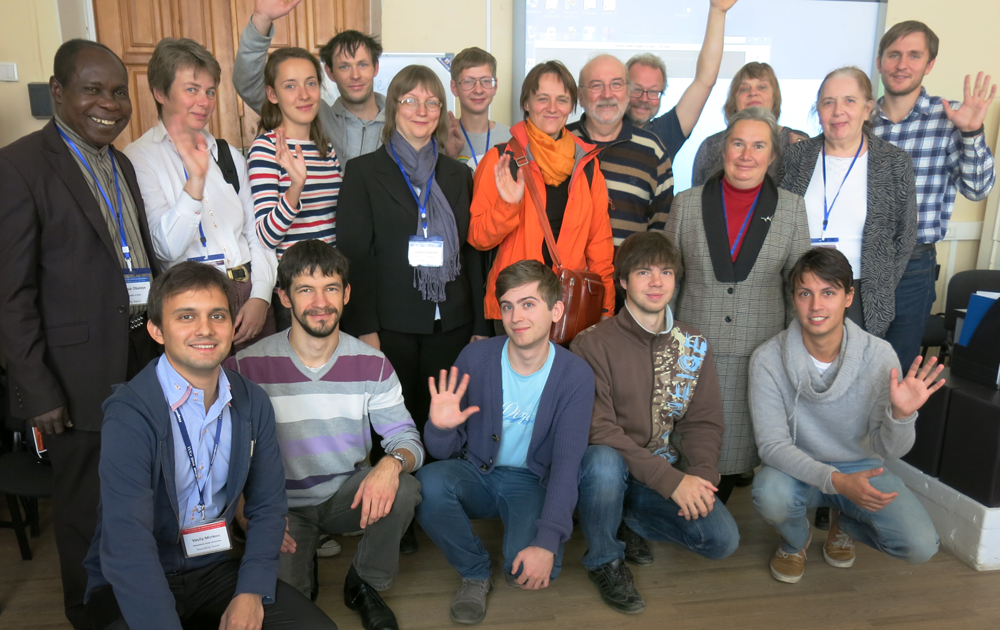Novosibirsk "speaks" crystallography
In October 2013, two events were celebrated in Novosibirsk (Russia) to talk about crystals and crystallography with school children and among scientists. Both were very successful, as you can see for yourself from these videos, photo gallery and reports.
Public lecture for secondary school children at the Russian Academy of Science, Novosibirsk, 30 October 2013
Elena Boldyreva, Institute of Solid State Chemistry and Mechanochemistry, Novosibirsk State University, Russiaeboldyreva@yahoo.com
A report and press release are available here.
"Frontiers in Crystallography", Novosibirsk, 2-6 October 2013
Elena Boldyreva, Institute of Solid State Chemistry and Mechanochemistry, Novosibirsk State University, Russia
eboldyreva@yahoo.com
See the photo gallery
The workshop Frontiers of Crystallography was jointly organized by the Novosibirsk State University, the Institutes of Solid State Chemistry and of Geology and Mineralogy and the Siberian Branch of the Russian Academy of Sciences. The school was dedicated to the forthcoming International Year of Crystallography and was supported by Novosibirsk State University, Institute of Geology and Mineralogy, Institute of Solid State Chemistry and Mechanochemistry of the Siberian Department of Russian Academy of Sciences, and by the IUCr. Agilent Technologies organized a pre-school satellite seminar on the use of instrumentation for high-pressure diffraction. STOE took care of several instruments (STOE STADI-4 equipped with Ag-tube, IPDS-2T, IPDS-II, STADI-MP) that were used during the School for tutorials and demonstrations. The principles of the diamond anvil cell (DAC) were explained using different models produced by Almax-Easylab by Hans Ahsbahs (Marburg), Ronald Miletich (Wien) and Alexander Kurnosov (Bayreuth).

 This was the first School in this format in Russia and it was very well attended. We hosted 37 young participants from Russia (Novosibirsk, Krasnoyarsk, Omsk, Moscow, St Petersburg, Nizhnii Novgorod, Irkutsk), Germany, Japan, Nigeria and United Kingdom. Participation in the lectures and tutorials was free for everyone. Moreover, thanks to the support of the IUCr, 10 participants received partial or complete (depending on the expenses) refunds for travel and lodging costs. Thirteen lecturers from Russia, United Kingdom, Germany, Spain, Austria, Italy, Canada and Sweden are to be thanked for the top-quality level of their lectures, tutorials, demonstrations, as well as for the very interesting program that was multi-faceted and coherent at the same time. The lecturers are also thanked for their enthusiasm and for raising their own funds for coming. Two lecturers were supported by the IUCr within the Visiting Professorship program. Partial support came from the Novosibirsk State University.
This was the first School in this format in Russia and it was very well attended. We hosted 37 young participants from Russia (Novosibirsk, Krasnoyarsk, Omsk, Moscow, St Petersburg, Nizhnii Novgorod, Irkutsk), Germany, Japan, Nigeria and United Kingdom. Participation in the lectures and tutorials was free for everyone. Moreover, thanks to the support of the IUCr, 10 participants received partial or complete (depending on the expenses) refunds for travel and lodging costs. Thirteen lecturers from Russia, United Kingdom, Germany, Spain, Austria, Italy, Canada and Sweden are to be thanked for the top-quality level of their lectures, tutorials, demonstrations, as well as for the very interesting program that was multi-faceted and coherent at the same time. The lecturers are also thanked for their enthusiasm and for raising their own funds for coming. Two lecturers were supported by the IUCr within the Visiting Professorship program. Partial support came from the Novosibirsk State University.
In addition to the very "close-packed" scientific and educational program, a series of events for the general public and for children was organized. Prof Juan-Manuel Garcia Ruiz gave two evening lectures at the Science-Café "Eureka" and a comprehensive lecture on crystals and crystallography for school children. The lectures were followed by the projection of the movie "The mystery of giant crystals" and a quiz with prizes for the best questions and the best answers.
The first topic was covered by Juan-Manuel Garcia Ruiz (Granada, Spain) [Patterns on the rocks: crystals in Nature. I. Mineral growth pattern in geology, II. Mineral growth pattern in organisms (biomineralization)], Hanna Dabkowska (Hamilton, Canada) [Crystal growth of magnetic oxides], Anton Shatsky (Novosibirsk, Russia) [Crystal growth of high-pressure minerals], Konstantin Litasov (Novosibirsk, Russia) [High-pressure synthesis of superhard nanopolycrystalline diamonds and related materials: current progress and implication to natural occurrences], Yurii Palyanov (Novosibirsk, Russia) [Growth of artificial diamonds as large single crystals], Ross Angel (Padova, Italy) [Where do diamonds grow. A crystallographic approach]. In addition to the lectures, the participants of the School visited the Mineralogical Museum of the Institute of Geology and Mineralogy (Siberian Branch of the Russian Academy of Sciences), as well as the facilities used to grow large single crystals of artificial crystals (including diamonds) at high pressure (BARS, a multi-anvil large-volume press).
High-pressure crystallography was considered in great detail. Lectures were given by Elena Boldyreva (Novosibirsk, Russia) [High-pressure in research of supramolecular systems], Colin Pulham (Edinburgh, UK) [High-pressure research of energetic materials]. Ronald Miletich (Wien, Austria), Ross Angel (Padova, Italy), Clivia Hejny (Innsbruck, Austria), Karen Friese (Julich, Germany) and Andrzej Grzechnik (Aachen, Germany) gave a series of detailed lectures, demos and tutorials on all possible aspects of high-pressure diffraction techniques: creating and measuring pressure in diamond anvil cells, sample preparation, data collection, data processing, structure solution, structure refinement, precise measurement of cell parameters, and preparing data for publication. Alexander Kurnosov (Bayreuth, Germany) gave a lecture on the combination of high-pressure X-ray diffraction with Brillouin spectroscopy, and Boris Zakharov (Novosibirsk, Russia) on the combination of high-pressure X-ray diffraction with Raman spectroscopy. Ross Angel (Padova, Italy) also gave lectures on elastic tensors and bulk moduli and on the effect of non-hydrostatic stress on cell parameters.
The third topic of the School was dedicated to twins and aperiodic structures studied at ambient and high-pressure conditions. Karen Friese gave a very clear introduction into the diffraction studies of twinned structures and a general introduction to superspace. Nadezhda Bolotina (Moscow, Russia) gave a very detailed introduction into JANA with several days of tutorials, during which some of the students could even solve the crystal structures of their own samples! Sven Lidin (Lund, Sweden) came to Novosibirsk just for Saturday and half of Sunday, apparently being pressed for time because of the start of the Nobel week in Stockholm immediately after our School, to give illuminating lectures on modulations in intermetallics and on the powder refinement of modulated structures. Many participants will remember for the rest of their lives that "reciprocal space is the best place to stay" and "the dark ages of crystallography" are those when people did not care about looking at their structures in reciprocal space.
The week in Novosibirsk was filled with intensive learning, making new scientific and personal contacts, various cultural events and peaceful walks in the autumn forests of Akademgorodok. This was a good start for IYCr2014 in Novosibirsk.


